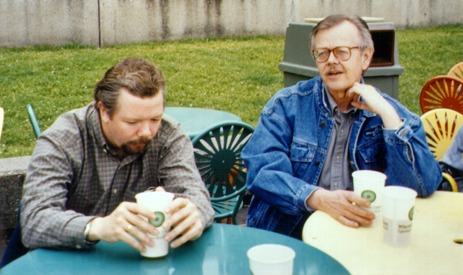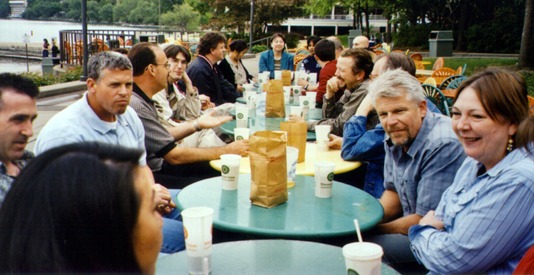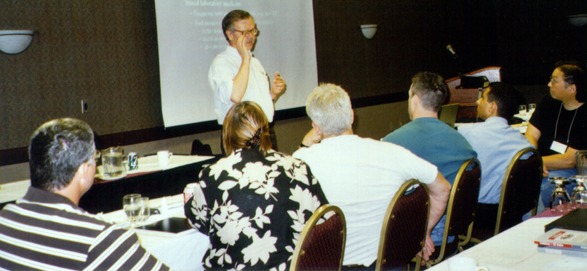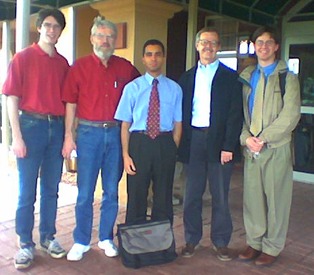Personal
Giving Thanks for 2003: Some Observations
December 2003
The year 2003 saw Dr. Westgard in 36 different cities in the US and 8 foreign countries. Dr. Westgard met with or spoke to over 5,000 professionals in the clinical lab sciences this year. After this whirlwind of travel and talk, he gives thanks and offers some observations on the state of Quality Management
- #1: Strong interest in (and need for) quality persists
- #2: The compliance mentality has become a barrier
- #3: CLIA is Final, but it's still confusing and ineffective
- #4: People still want education and training to solve problems and implement improvements
- #5: People are seeking new ways to improve quality
- #6: Clinical Lab Scientists are still needed and we have much work to do!
- #7: Thanks for your participation!
- References
 |
|
One of my 2003 appearances in Italy: This particular lecture was on Quality for Blood Gas |
It's a bit early to begin a year-end retrospective, but before the deluge of “Best of”, “Worst of”, and “Top 10” lists begin, I wanted to get in my own review of this year of 2003. There are a lot of people to thank, a lot of developments to consider.
I have been traveling a lot lately. Looking at my calendar just from October 2002 through October 2003, I find that I have visited no less than 36 different cities and 8 foreign countries[1]. Some of these trips were conferences, others were workshops, still others were consulting trips for individual labs or manufacturers. But I estimate that in the last 12 months, I have spoken to or with approximately 5,000 people affiliated with the clinical laboratory sciences.
In that same time period, traffic on Westgard Web has increased to a new high. A year ago, if we received 5,000 visitors in a week, we considered that heavy traffic. That is now our “low” – a good week on the website now reaches 9,000 to 10,000 visitors, and our email newsletter has grown to 4,500 people. While we are never going to be in danger of achieving the same kind of traffic that a Google or Amazon attracts, we believe that getting the regular attention of so many laboratory professionals is a rare (and good) thing.
I mention these travels and traffic as a prelude to the heart of this essay. I hope to provide a capsule about what I see as the state of quality management in the clinical laboratory. Having established the breadth of my experience in this last year, I hope that you will accept my assessments as a reasonable perspective of the state of quality today.
#1: There continues to be a strong interest in quality issues, especially from analysts and technical managers.
"In my current laboratory we have on more than one occasion accepted out of range QC and thus affected > 100 patient results. In some cases potential for a sentinel event. In talking to the technologists they continue to tell me they really don't know how to review QC." - Excerpt from an email received at Westgard Web 11/26/03.
Simply by head count and traffic count, I can tell you that the thirst for knowledge (and solutions) about quality control has not stopped. If anything, it is building, particularly for bench level analysts and their immediate supervisors. I'm certainly traveling more this year than the year before. More and more people have attended workshops or lectures, visited our company booth, visited our website, etc. There are some healthcare professionals who suggest (or at least hope) that the quality issue has been dealt with and now we can move on. I don’t think that is true and most people that I’ve met in my travels value quality and are sincerely looking for ways to improve laboratory performance and service.
As the pressure for productivity increases and the complexity of instrumentation increases, the issue of quality control gets more complicated, not less. And good quality control becomes even more important, not less. Now more than ever, the laboratory is under extreme pressure to produce good test results at a faster and faster pace. If the goal is only to get more results out the door, then quality control becomes a problem. For some business oriented managers, the extra time needed to resolve problems is seen as impeding the efficiency of the laboratory and delaying the reporting of test results.
Given that it will be more and more difficult to find well-trained clinical laboratory scientists in the future, these problems will only be further exacerbated. Laboratories are now looking to manufacturers to solve their problems, and some manufacturers are starting to step up to the plate and do a good job.
#2. The compliance mentality of healthcare organizations has become a barrier to quality improvement in the US.
One of the benefits from all my travel to other countries is the chance to compare the interests, trends, and emerging practices in quality management. Having done this for many years, I can see the long range impact of the strong regulatory environment in the US as compared to other countries and provinces where the professional environment provides the motivation and defines the responsibility for quality.
It is sad to say, but the biggest roadblock for solving the problems with quality in the US today is actually the “compliance mentality” that has developed in the last ten years, particularly with high level managers and directors in healthcare organizations. With publication of the Final CLIA Rule, the government has approved further reductions in QC, to the point where QC may be required only daily, or weekly, or even monthly. Now laboratory scientists will have to struggle with hospital administers and managers to defend even daily QC. Let me ask if anyone would knowingly submit your partner, children, or grandchildren to treatment at a medical facility if you knew they employed this minute level of quality control. If it’s not good enough for own families, then it isn’t be good enough for our patients either.
A related observation that I want to share is that the interest in quality in veterinary medicine is increasing more than in healthcare laboratories, particularly for high level managers and directors. This year saw the attendance of a number of veterinary medicine professionals at our Madison workshops. I am also being invited to make presentations at their professional meetings. I think this reflects the fact that quality is still a professional responsibility in the veterinary laboratory, rather than being a compliance issue in many healthcare organizations. Strange to think that, at this rate, our animals may receive better testing services than we do. But maybe we can learn something from our pets.
#3: CLIA may be Final, but it still confusing and ineffective!
In late July, we attended the AACC/ASCLS conference in Philadelphia. This is always a highlight of the year for us, as we get the opportunity to see so many of our website visitors. Placing faces to email addresses is great. It reminds us that our Internet efforts aren't merely bits and bytes.
At the conference, I had the pleasure of presenting a workshop on The CLIA Final Rule, along with John Yundt-Pacheco. Remember, this is the version that has the new language that requires QC to provide “immediate error detection.” The night before, as part of our preparation for the workshop, John and I (with the staff of Westgard QC in tow) prepared for our presentation by visiting one of Philadelphia's seedier bars. We tried out a beer called Monkey Knife Fight and, on a personal level, found out about immediate error detection, in this case, the error of our ways. Luckily, we recovered in time for the workshop the next morning.

Dr. John Yundt-Pacheco and I, having beer on a different occasion.
The CLIA Final Rule has dominated this year. The immediate impact could be seen in the switch to a “waived/non-waived” system for classifying tests, new requirements for laboratories to validate new methods implemented after April 2003, and new requirements for QC. I guess it must be considered progress to have the Final Rule published. At the same time, the Final Rule wasn't really the final word in CLIA. Now we’re waiting for publication of “interpretive guidelines”, or the State Operations Manual (SOM), that advises inspectors how to implement the rules.
One new and interesting aspect of the SOM is the guidelines for validating “equivalent” quality control procedures. This is sort of as an end run around the regulations, probably in an effort to find some way out for “electronic QC” which had been temporarily allowed prior to the Final Rule. It is beginning to look like the SOM is the way that CLIA will “evolve” in response to pressure from different stakeholders. What was once just a minimum for QC (with the implication that you should be doing more) can now be reduced from daily to weekly and even monthly QC.
I think that ultimately that CLIA will become irrelevant. We have reached the point, or soon will, where the regulations are so minimal that no one will in good conscience will be satisfied to perform work of such low quality. When the bar is set so low and there is no scientific evidence to justify it, a new “higher” bar will have to be established by someone other than CLIA. Hopefully laboratory professionals will step up and raise that bar.
#4: People continue to want education and training to solve problems and implement improvements.

Some of the Westgard "Class of 2003"
In June, we held our 3rd annual “Westgard Workshops”, this time addressing Method Validation issues in addition to Six Sigma topics. Attendance has grown for these workshops each year, despite the “remote” location of Madison, Wisconsin. With every workshop we give, I am more and more impressed by the attendees and their interests in laboratory quality management. Of course, this is a self selected group who attend because they are interested and committed. And each year, it has been easier to convince them of the need for better quality control tools and processes. I think we've now reached a point where professionals truly no longer accept the status quo of poor QC. Now they are actively seeking solutions.

A tradition of the Westgard Workshops - Beer and popcorn on the University of
Wisconsin'sMemorial Union terrace
Part of the benefit of a workshop series like we give is how much time it takes. Typically, as professionals we are given only an hour or two to present or explain or understand a new concept. This is rarely enough time to give anything but a broad overview of that topic. I have given many presentations, both short and long, and it's the long ones that work the best. But it's not that in the longer time frame, you present more material. It's just that the participants have more time to understand the material and get comfortable with it. Certainly it's possible to learn everything you need to know about QC, or Six Sigma, or CLIA, in a very short amount of time. But to comprehend it, to be able to relate personally to it, is a very different matter. When people attend our workshops over the course of a few days, they have the time to immerse themselves in the concepts. They are also removed from the pressure of their normal professional and personal lives. I often like to refer to the workshop as a retreat more than a lecture or seminar. It's a chance to take some time away from the crushing pressure of the deadlines and schedules and the workload that is de jure for the laboratory.

The actual "work" of the workshops. For everyone involved, it's an intense day.
A corollary observation I can make is that people still learn best in person. Without doubt, our website reaches a far wider audience than any workshop can do -- more people visit the website in a week than I can talk to (see above) in a year. And more people take our online courses than attend our workshops. And yet, the face to face contact that occurs during the Westgard Workshops has such an impact on the participants. Some of our workshop participants have been regular visitors to the website for years, but it was the personal contact that crystalized the ideas for them. It just confirms the primacy of face to face teaching and interactions. We are stimulated to learn when it is a human voice we are listening to, a human face we are watching. And in an environment where we can ask questions and get responses, the learning process is accelerated. Technology has made it easier to learn without the human presence, but I believe the most effective learning will always come from personal instruction, of lessons handed down from a teacher to a student.
#5 “...we don't have CLIA but we have other problems” – People are trying new things, looking for new solutions to Quality challenges
This quote comes from my good friend Dr. Paulo Pereira from Portugal. He attended the Westgard Workshops in June, and, when asked at one point to describe his reaction to some of the material, he said this “In Portugal we don't have CLIA, but we have other problems.” I think this captured the essence of what CLIA has become. It was supposed to be a solution to the Quality problem. Instead is has become a bigger problem in itself – in addition to the Quality problem.
As Paulo correctly indicated, CLIA doesn't impact the rest of the world. In Europe and other countries, they have their own standards and guidelines that they must meet. There are several international movements that have come to prominence in the last year.
ISO continues to grow in importance. Labs are now facing the prospect of having to conform to concepts of “trueness and uncertainty” instead of the more traditional, and still appropriate, concepts of accuracy and precision. ISO standards are useful in many areas, and the process of getting accredited by ISO forces organizations to think hard and define what they're trying to do in each process. However, ISO isn't all-powerful. We have posted discussions by some Scandinavian scientists who raise serious questions about the GUM (Guide to Uncertainty in Measurements). As ISO accreditation becomes more popular in the US, we will see a more critcal appraisal here as well.
Six Sigma is getting bigger and bigger as a quality improvement trend. A few years ago it was strange to hear these concepts discussed in healthcare. Now it's so commonplace it's almost become a cliché. I think few people in our field really understand what Six Sigma is and how easy it is to apply to our analytical testing processes. And very few companies, even commercial laboratories, are applying it to the core analytical testing processes. It seems like hospitals and healthcare corporations are using it to speed up their billing cycles, eliminating the delays that prevent them from getting paid. Eventually, I hope they will apply these defect-reducing tools to actually improve patient care.
“Lean” is just starting to receive some attention. CAP Today had an article on it, which signals that it has reached a certain threshhold of awareness and popularity. Lean focuses on reducing cycle time and complexity in systems and processes. It is often paired with Six Sigma. The one-two punch of simplying process and reducing defects looks like an effective quality improvement strategy. We will start addressing Lean on Westgard Web in 2004.
All of these “new approaches” have some value to offer. In combination, they can be powerful. But none are a panacea, and none of them will help patient care if analytical testing is left to rot. At the center, testing is about quality requirements, bias, and imprecision. Those numbers don't go away no matter what management approach you adopt.
#6. Clinical laboratory scientists are still needed and we have much work to do!
This is the good news and the bad news. We’re still very much needed in this new age of medicine, though we may not be properly appreciated. Laboratory tests are more important than ever, but everyone assumes the results will be correct because of the complex technology that is involved in making the measurements. People believe they can buy quality tests off the shelf from commercial laboratories, from the manufacturers of analytical systems, and even from drug stores. While I will acknowledge the capabilities of pharmacies to count pills correctly, that counting skill doesn’t qualify them to make laboratory measurements. I know that comment is ludicrous, but it is also ludicrous that pharmacies now want to become testing centers. That only shows the lack of understanding of the difficulties in guaranteeing the quality of test results today. We are still needed and we have much work to do!
#7: Thank you for your participation!
 |
|
Some of the staff of Westgard QC. From, left Rob Kennedy, Software Quality Assurance Director, Robert Kennedy, VP of Software Development, Dr. Paulo Pereira (not actually employed by Westgard QC, but very helpful in his feedback to us), Dr. Westgard himself, and Sten Westgard, publications coordinator. |
As regular visitors to this website already know, 2003 was a good year for me, and I have already written one essay giving thanks. However, I never act alone. It's your reactions and feedback and comments and even your criticisms that keep me going. Even by reading this essay, you're letting us know what's important to you.
The list of people I need to personally thank is very, very long. To all of my hosts, to everyone who came to hear me speak, to those of you who visit the website and read our postings (and email us, on occasion), I sincerely thank you.
From the entire staff of Westgard QC, we say thank you to our customers and visitors. Many of our articles now come from data that you submit to us, or address real-world questions that you send to us. We strive to exceed your expectations.
And we hope that in 2004, we'll have a chance to meet more of you, or at least hear from more of you.
References
In alphabetical, not chronologic order: Atlanta, Antwerp, Baltimore, Barcelona, Boston, Belfast, Brescia, Brussels, Chicago (4 times), Dallas (twice), Detroit, Dublin, Houston (twice), Lisbon, London, Montreal, Munich, New Orleans (twice), Padova, Paris, Pearl River in NY, Philadelphia, Phoenix, Raritan Center in NJ, Richmond, Rome, St. Louis, Salt Lake City, San Antonio, San Francisco, Toronto, Turin, Washington DC. And this doesn't even take into account the visits to my grandchildren! So, if you are wondering, yes, I do have a lot of frequent flyer miles.
James O. Westgard, PhD, is a professor of pathology and laboratory medicine at the University of Wisconsin Medical School, Madison. He also is president of Westgard QC, Inc., (Madison, Wis.) which provides tools, technology, and training for laboratory quality management.
